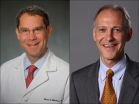INFORMATION:
New Notre Dame study examines important Ebola protein
2014-12-10
(Press-News.org) A new study by Robert Stahelin, an adjunct associate professor of chemistry and biochemistry at the University of Notre Dame and an associate professor at the Indiana University School of Medicine-South Bend, as well as a member of Notre Dame's Eck Institute for Global Health, investigates how the most abundant protein that composes the Ebola virus, VP 40, mediates replication of a new viral particle.
"In brief, the Ebola virus has just seven proteins that encode in its genome," Stahelin said. "VP40 is critical to the formation of a new viral particle and it does this by interacting with lipids inside human cells."
Stahelin and co-investigator Smita Soni, a postdoctoral researcher at the Indiana University School of Medicine, found that VP40 is able to assemble in vitro (i.e., in a test tube), without any human cells present and mediate formation of virus-like particles when the human lipid phosphatidylserine is found in solution with VP40, but not other control lipids.
"This means, in conjunction with our previous research papers, that Ebola virus VP40 can assemble and interact with human phosphatidylserine to generate the lipid coat of the virus," Stahelin said. "For completeness sake, Ebola virus is a lipid-enveloped virus and gets its lipid bilayer coat from the human cell it infects. In essence, Ebola VP40 is assembling on phosphatidylserine-enriched regions of human cells to form the long filamentous virus particle we are so familiar with seeing."
The long-term objective of Stahelin's research is to apply principles learned from biochemical and biophysical studies to generate novel therapeutics to combat Ebola.
"This study has greatly helped us understand how the Ebola virus replicates and should at least allow us to test some new drug leads and hypothesis," he said.
In assessing the status of the current Ebola outbreak, Stahelin sees both cause for hope and cause for concern.
"It seems that the Ebola crisis is being managed better than months earlier and in some regions, especially those in Liberia, hasn't been spreading at the rates seen earlier," he said. "However, it will still be nine months, if not more, before full control can be obtained. The recent spread to Mali is of concern."
Stahelin's and Soni's study appears in the Journal of Biological Chemistry.
ELSE PRESS RELEASES FROM THIS DATE:
Ads communicate message in as little as tenth of a second, helped by color: INFORMS study
2014-12-10
Ads can communicate their main message in as little as a tenth of a second, helped by color, according to a new study published in Marketing Science, a publication of the Institute for Operations Research and the Management Sciences (INFORMS).
The Buffer Effect: The Role of Color When Advertising Exposures Are Brief and Blurred is by Michel Wedel, Pepsico Chaired Professor of Marketing at the Robert H. Smith School of Business of the University of Maryland and Rik Pieters, Professor of Marketing at the Tilburg School of Economics and Management of the University of Tilburg ...
Predator versus prey
2014-12-10
A sex-changing fish called California sheephead (Semicossyphus pulcher) plays a vital role in the food web of kelp forests along the Pacific coast. Commonly found in the waters from Baja California to Point Conception -- although they can sometimes be found as far north as Monterey Bay -- sheephead feed on sea urchins, whose grazing habits can wreak havoc on community composition in kelp forests.
A new study by UC Santa Barbara research biologist Jenn Caselle uses data from three decades of research to document differential exploitation and recovery of sheephead populations ...
Study shows no lead pollution in the oil sands region of Alberta
2014-12-10
Recent research from the University of Alberta reveals that contrary to current scientific knowledge, there's no atmospheric lead pollution in the province's oil sands region.
William Shotyk, a soil and water scientist who specializes in heavy metal pollution, examined sphagnum moss from 21 separate peat bogs in three locations around the oil sands area, near open pit mines and processing facilities.
After measuring the heavy metal content in the moss samples in his ultra-clean lab at the University of Alberta, Shotyk, based in the Faculty of Agricultural, Life and ...
Pathway that degrades holiday turkey fuels metastasis of triple negative breast cancer
2014-12-10
A University of Colorado Cancer Center study being presented at the San Antonio Breast Cancer Symposium shows that triple negative breast cancer cells process tryptophan to promote survival while traveling through the body in order to seed new tumor sites.
"I'm not saying that people with metastatic breast cancer shouldn't eat turkey during the holidays, but triple-negative breast cancer appears to have found a way to process tryptophan more quickly, equipping cancer cells to survive while in circulation, which allows them to metastasize," says Thomas Rogers, the paper's ...
Microbiologists discover how gut bacterial resources are hijacked to promote intestinal illnesses
2014-12-10
DALLAS - Dec. 10, 2014 - UT Southwestern Medical Center microbiologists have identified key bacteria in the gut whose resources are hijacked to spread harmful foodborne E. coli infections and other intestinal illnesses.
Though many E. coli bacteria are harmless and critical to gut health, some E. coli species are harmful and can be spread through contaminated food and water, causing diarrhea and other intestinal illnesses. Among them is enterohemorrhagic E. coli or EHEC, one of the most common foodborne pathogens linked with outbreaks featured in the news, including ...
Physicists explain puzzling particle collisions
2014-12-10
An anomaly spotted at the Large Hadron Collider has prompted scientists to reconsider a mathematical description of the underlying physics. By considering two forces that are distinct in everyday life but unified under extreme conditions like those within the collider and just after the birth of the universe, they have simplified one description of the interactions of elementary particles. Their new version makes specific predictions about events that future experiments at the LHC and other colliders should observe and could help to reveal "new physics," particles or processes ...
Organic electronics could lead to cheap, wearable medical sensors
2014-12-10
BERKELEY -- Future fitness trackers could soon add blood-oxygen levels to the list of vital signs measured with new technology developed by engineers at the University of California, Berkeley.
"There are various pulse oximeters already on the market that measure pulse rate and blood-oxygen saturation levels, but those devices use rigid conventional electronics, and they are usually fixed to the fingers or earlobe," said Ana Arias, an associate professor of electrical engineering and computer sciences and head of the UC Berkeley team that is developing a new organic optoelectronic ...
New drug combination for advanced breast cancer delays disease progression
2014-12-10
New Haven, Conn. - A new combination of cancer drugs delayed disease progression for patients with hormone-receptor-positive metastatic breast cancer, according to a multi-center phase II trial. The findings of the randomized study (S6-03) were presented at the 2014 San Antonio Breast Cancer Symposium, held Dec. 6-9, by Kerin Adelson, M.D., assistant professor of medical oncology at Yale Cancer Center and chief quality officer at Smilow Cancer Hospital at Yale-New Haven.
The trial enrolled 118 post-menopausal women with metastatic hormone-receptor-positive breast cancer ...
Most women with early-stage breast cancer in US receive radiation for too long
2014-12-10
PHILADELPHIA--Two-thirds of women treated for early-stage breast cancer in the U.S. receive longer radiation therapy than necessary, according to a new study published in JAMA this week from Penn Medicine researchers Ezekiel J. Emanuel, MD, PhD, and Justin E. Bekelman, MD. Their findings reveal that the vast majority of women after breast conserving surgery receive six to seven weeks of radiation therapy, despite multiple randomized trials and professional society guidelines showing that three weeks of radiation - called hypofractionated whole breast radiation - is just ...
Many breast cancer surgery patients do not receive shorter radiation treatment
2014-12-10
Although the use of a type of radiation treatment that is shorter in duration and less costly has increased among women with early-stage breast cancer who had breast conserving surgery, most patients who meet guidelines to receive this treatment do not, according to a study appearing in JAMA. The study is being released to coincide with the San Antonio Breast Cancer Symposium.
Breast cancer accounts for the largest portion of national expenditures on cancer care, estimated to reach $158 billion in 2020. Breast conservation therapy is the most common treatment for early-stage ...



